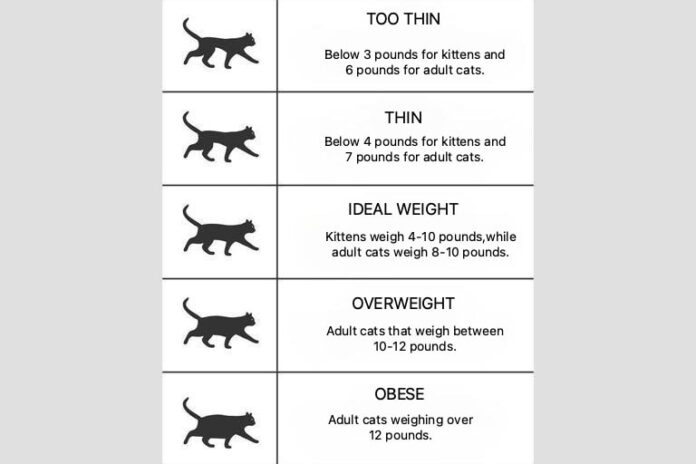Ever wonder what’s the ideal weight for your kitty? The optimal weight for your furry pal isn’t an exact science.
Luckily, there are a few recommendations that can help you determine your cat’s ideal weight.
This cat overweight chart provides facts you need to know to keep track of your cat’s weight—from monitoring their progress to identifying possible health issues.
Read on to learn how to tell if your cat is overweight and to determine the average weight of kittens and cats.
Why Does Your Cat’s Weight Matter?
The Association for Pet Obesity and Prevention reports that about 60% of cats in the U.S. are overweight or obese.
Cats look cute when they’re plump. However, excess weight can lead to multiple health issues.
An overweight cat is at risk of the listed problems below:
- Diabetes
- Skin problems
- Heart failure
- High blood pressure
- Joint injuries
Furthermore, being overweight makes your cat’s grooming and playtime more challenging.
Hence, maintaining your cat’s correct weight is crucial to its mental and physical wellness.
How to Tell if My Cat Is Overweight?
As a pet owner, you have to track your kitty’s weight. Here are four signs that your cat is carrying a few extra pounds.
1. Difficulty Feeling the Ribs
By gently stroking your palm over your cat’s chest the first time, you’ll feel their ribs when they’re at an ideal weight.
However, your kitty is overweight if you can’t feel its ribs.
2. Lack of Waist Definition
As your cat is standing, look down at it from overhead. Check for the small indent over your cat’s hips. This is where its waist should be.
If you can’t feel its waist indention or if the belly area is rounding, your cat is overweight.
3. Difficulty in Jumping and Moving Around
Cats are naturally jumpy. If your cat takes several tries to jump a piece of furniture or has challenges climbing stairs, its weight might be the reason.
4. Use the Cat Overweight Chart
Check the chart below to fully explain your cat’s weight range. Generally, this chart includes the following weight classes:
Too Thin
Below 3 pounds for kittens and 6 pounds for adult cats.
Thin
Below 4 pounds for kittens and 7 pounds for adult cats.
Ideal Weight
Kittens weigh 4–10 pounds, while adult cats weigh 8–10 pounds.
Overweight
Adult cats that weigh between 10–12 pounds.
Obese
Adult cats weighing over 12 pounds.
How Can I Support My Cat To Lose Weight?
To effectively help your cat to lose weight, here’s what you need to know.
- Give them food in reduced portion sizes
- Increase their activity level or playtime
- Switch to wet food
- Give low-calorie treats
- Modify your feeding patterns
Summary
Ultimately, keeping track of your cat’s weight is critical for its overall health. With this cat overweight chart, you can ensure that your feline friend is at an ideal weight and not at risk of health concerns.
Moreover, it’s best to make dietary and activity adjustments if you faced difficulties feeling your cat’s ribs, noticed a lack of waist definition, or had challenges moving around.
Remember that consistent and healthy eating patterns, exercise, and regular vet visits will all benefit your pet’s health and well-being.
